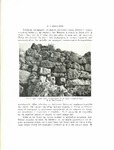| dc.creator | Μυλωνάς, Γεώργιος Ε. | el |
| dc.date.accessioned | 2015-05-05T13:40:15Z | |
| dc.date.available | 2015-05-05T13:40:15Z | |
| dc.date.issued | 1966 | |
| dc.identifier.uri | http://hdl.handle.net/11615/3512 | en |
| dc.description.abstract | A full description and plans of this Gate are to be found in my study published
in the Charisterion to A. K. Orlandos, vol. A., pp. 213-227; its details
therefore are not repeated here. Our work around the Gate in 1958, supervised
by Dr. Sp. Iacovides, disclosed that it is a later addition built in a breech of
the North Cyclopean Wall made for the purpose. Originally that wall was
continuous in that area. This is proved by three of its original blocks still in situ
(Pi-9, A y- <5)· The fill of the Cyclopean Wall was revealed behind these stones (PL 9, β') and on this fill are based the conglomerate blocks of the bastion.
That the Gate and its bastion are a later addition can also be adduced from
the way the bastion is attached to the North Cyclopean Wall (Fig. 13) and from
the drains I and K (Fig. 14 and PI. 10) which were built to serve the inner
court of the Gate. A comparison of these drains to those originally made in the
North Cyclopean Wall (PI. 11 and Fig. 22) will prove the late date of their
construction and of the walls of the Gate in which they were placed. The foundation
blocks of the North Wall were laid directly on the rock without the intervention
of a clay bedding (PI. 12 and Fig. 15). Such clay was employed in
the construction of the West Cjmlopeau Wall (PI. 13) of the Lion Gate and its
bastion (Figs. 36 and 37) and in the construction of the Postern Gate and its
bastion. This use of clay is a later development in Mycenaean construction and
indicates a late date for the Postern Gate. The systematic excavation of the fill
of the passage to the Gate (Figs. 16, 17, and 18) revealed undisturbed areas
yielding numerous sherds. The painted sherds found under its threshold and in
its passage are illustrated in Figures 23 and 24; those found in the fill of the
road which originated at the inner facade of the Gate are shown in Figure 27.
The latest sherds found belong to a later phase of LH III B and prove that
the Postern Gate was constructed after the middle of the thirteenth century B. C.
The latest painted sherds are somewhat later than those found in the area of the
Lion Gate and indicate that the construction ot the Postern Gate followed that
of the Lion Gate. | en |
| dc.language.iso | el | en |
| dc.publisher | Η εν Αθήναις Αρχαιολογική Εταιρεία | el |
| dc.rights | Attribution-NonCommercial-NoDerivatives 4.0 International | en |
| dc.rights.uri | http://creativecommons.org/licenses/by-nc-nd/4.0/ | en |
| dc.subject | Citadel of Mycenae | en |
| dc.subject | Postern gate | en |
| dc.subject | Archaeology - Archeology | en |
| dc.subject | Ακρόπολη Μυκηνών | el |
| dc.subject | Βόρεια πύλη | el |
| dc.subject | Αρχαιολογία | el |
| dc.title | Η βορεία πύλη | el |
| dc.type | journalArticle | en |
| heal.recordProvider | Πανεπιστήμιο Θεσσαλίας - Βιβλιοθήκη και Κέντρο Πληροφόρησης | el |
| heal.journalName | Αρχαιολογική εφημερίς : εκδιδομένη υπό της εν Αθήναις Αρχαιολογικής Εταιρίας | el |
| heal.fullTextAvailability | true | en |
| dc.rights.accessRights | free | en |
| dc.identifier.bibliographicCitation | Αρχαιολογική Εφημερίς, 1962, Τόμος 101, 27-50. | el |



